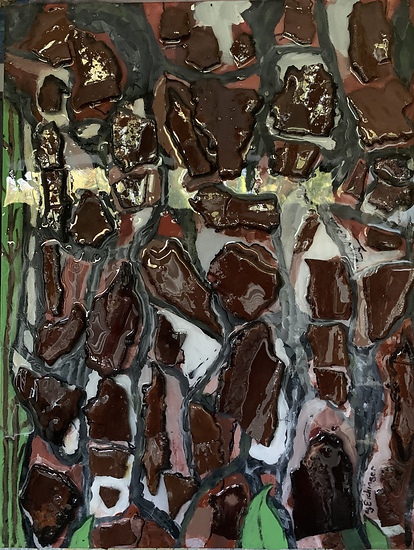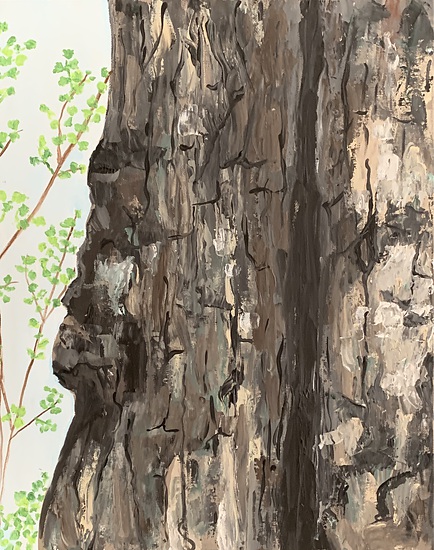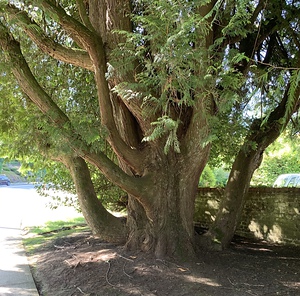I think that I shall never see
A poem lovely as a tree.
A tree whose hungry mouth is prest
Against the sweet earth’s flowing breast;
A tree that looks at God all day,
And lifts her leafy arms to pray;
A tree that may in summer wear
A nest of robins in her hair;
Upon whose bosom snow has lain;
Who intimately lives with rain.
Poems are made by fools like me,
But only God can make a tree.
—From “Trees” by Joyce Kilmer
There once was a woodsman who worked very hard but was never content. One day, a old hermit saw him in the woods and the two men got to talking. At the end of a pleasant hour, the wise man revealed that he had special powers and would grant the woodsman three wishes. He was told to call out “Raven, Raven, Raven” and he would come to grant his wish. The woodsman thought for a moment and said, “I want a wish now. I am lonely and would like a wife to share my bed and keep me warm at night.”
That evening, on his way home from work he passed a maiden traveling in the same direction. She had long hair the color of a red pine tree that sparkled in the sun. They smiled at each other and fell instantly in love. The couple got married and before long they had five children, three boys and two girls. After the birth of their fifth child, the woodsman’s wife complained that they needed a larger house, one that reflected his improved station in life, for he had become a lumberman who wore a shirt and tie to work.
The woodsman remembered the hermit he met in his youth. It had been a long time since their last meeting but he called out to see if he was a man of his word. ”Raven, Raven, Raven,” he cried and the old man appeared in his office. “My wife complains that the roof over our head is too small,” the woodsman said. “I need a house that make her happy and impress my business partners.
That evening when he returned from work, his wife gave him a smile as she did when they first met. She stood in front of a large red door with a brass knocker the size of his forearm. The white mega mansion before him had eight majestic columns that supported a porch with rocking chairs and a rocking horse for their youngest child. Inside were five bedrooms and a dining room table made of the finest mahogany that was large enough to accommodate his family and friends. The woodsman and his wife were content watching their children grow, marry, and have children of their own.
One day, the woodsman looked in the mirror and saw wrinkles and hair that was grey. He \went to the office but could only work a few hours before his back started hurting. It wouldn’t be long before he died, he thought. He started to brood, drank too much, and complained about the unfairness of life to all who would listen. Sitting alone in his rocker one day, he remembered he had one more wish he could ask of the hermit. “Raven, Raven, Raven,” he shouted in a grumpy, demanding voice.
The old man appeared at once. “What do you want now?” he asked annoyed. “You have a loving wife, a mansion to come home to, five children to give you grandchildren to bounce on your knee, and gold bars in your vault for retirement. What more could you need?”
“Use your magic to make me live as long as any living thing on earth so I can watch life pass through the ages,” he said.
In the blink of an eye, the hermit disappeared and the woodsman was turned into a 2,500 year old sequoia tree. He stood majestically by a trail in a western forest overhearing young lovers pass by and enjoying the feel of wind as it rustled its limbs. “I am the oldest and wisest tree alive in these woods,” he said to his neighbors. “I know all that is happening and watch people come and go as the years pass.”
Then, one day, a lumberman came by and saw the tree standing so taller than any tree in the woods. “Let’s cut it down, he said to his partner. We’ll make a lot of money and have firewood left over to bring home to our wives.” And so they did.
__________
I love trees. Many of my walks are at the arboretum where I’m especially aware of the shape and feel of the bark of various species. On narrow trails, it is difficult to look up at the crown of a tree without tripping on a root as I walk, so my eyes stay closer to earth. When I look around it is at head level where I take note of the trees’ bark. I am surprised at how soft and spongy California Redwoods and Giant Sequoias feel to the touch as compared to native Douglas Fir trees. Some of the bark is dark with deep furrows like the lines that gouge an old person’s face while other bark is lined with long textured.
Do you remember studying trees in biology class? It’s good to remember how these beautiful organisms cool the earth with their shade and release oxygen so we can breathe. Trees absorb carbon dioxide and the heat-trapping greenhouses gasses human activities emit. But, recent research shows that trees also communicate with each other. I wonder what they say as I walk by.
Best selling author and forester, Peter Wohlleben, in The Hidden Life of Trees: What They Feel, How They Communicate, was revolutionary when he wrote that trees of the same species are communal and form alliances with trees of other species. Botanists call his discovery of an underground fungal network the “wood-wide web.” They share water and nutrients through networks and communicate information about drought, disease and insect attacks. Distress signals are dispatched through hairlike root tips that join together with microscopic fungal filaments they use to send chemical, hormonal and slow-pulsing electrical signals that scientists are just beginning to decipher. They also communicate through the air, using scent signals.
Trees alter their behavior when they receive distress messages. For instance, trees in Africa can make their leaves taste bad when giraffes start nibbling on nearby branches. Trees can loan one another sugars where there are deficits from seasonal changes which is particularly beneficial between deciduous and coniferous trees. Crackling sounds heard in the roots of some plants are inaudible to humans and have yet to be interpreted.
When Wohlleben attended forestry school he was taught that trees needed to be thinned, that helicopter-spraying of pesticides and herbicides was essential, and that heavy machinery was the best logging equipment, even though it tears up soil and rips apart the mycorrhizae. He worked this way for more than 20 years until he visited a few privately managed forests in Germany, which were not thinned, sprayed or logged by machines. “The trees were so much bigger and more plentiful,” he observed. “Very few trees needed to be felled to make a handsome profit and it was done using horses to minimize the impact.”
At the University of British Columbia in Vancourver Canada, Suzanne Simmard and her grad students study the sensitivity and interconnectedness of trees in the temperate rainforests of western North America. They found that when a tree is cut, it sends electrical signals, analogous to pain, into its tissues. A group of scientists from Tel Aviv University also confirm that some plants emit a high-frequency distress sound when in environmental stress.
Simmard also identified some trees as hub trees, or “mother trees.” Mother trees are the largest trees in forests and act as central hubs for the network below-ground. For young saplings trying to survive in a shaded part of the forest, the network is a lifeline. Mother trees support seedlings by injecting them with a sugary fungi. They change their root structure to make room for baby trees. Simmard says that to have resilient forests in an era of rapid climate change, large trees need to be conserved for they form the heart of a forest’s communication network and are the lifeblood of the next generation.
Forests compose over 30 percent of the world’s land area, but are disappearing at an alarming rate. Between 1990 and 2016, 502,000 square miles were lost, an area larger than South Africa. Eighty percent of the Earth’s land animals and plants live in forests. Over 250,000 million people reside there and depend on trees for subsistence and income.
Countries that preserve forest ecosystems give conservationists a reason to hope. In addition to reducing carbon emissions and deforestation, billions of trees need to be planted across the globe and a sprinkling of nations are heeding their call. The Billion tree Campaign is managed by the nonprofit Plant for the Planet Foundation. Tree planing is the biggest and cheapest ways of taking CO2 out of the atmosphere to tackle the climate crisis. But, we need to start now because it will take 50 -100 years to reach its full effect of removing 200bn tonnes of carbon.
Below is the ranking of the top 100 countries in terms of how many trees they’ve planted last year.
| Ranking | Country | Trees Planted |
| 1 | China | 2,407,149,493 |
| 2 | India | 2,159,420,898 |
| 3 | Ethiopia | 1,725,350,234 |
| 4 | Pakistan | 1,006,776,724 |
| 5 | Mexico | 789,307,032 |
| 6 | Turkey | 711,103,088 |
| 7 | Peru | 646,502,236 |
| 8 | Nigeria | 626,725,667 |
| 9 | Kenya | 534,680,609 |
| 10 | United States | 315,586,982 |
A society grows great when old men plant trees whose shade they know they shall never sit in.”
–Greek Proverb
KNOW YOUR TREES
There are five parts to a tree;
- Crown
The top of the tree is the crown, made up of the leaves and branches that come in many shapes and sizes. The crown has numerous jobs:
- shades the roots
- collects energy from the sun (photosynthesis)
- keeps it cool by removing extra water
- Roots
Trees have a lot of underground roots — the size of the root system is usually as big as the part of the tree above the ground. This is essential because the roots help support the tree so it won’t fall over, but its main job is to collect water and nutrients from the soil and to store them for times when there isn’t as much available.
- Leaves
Leaves, part of the crown of a tree, convert energy into food, which is mostly sugar. They contain chlorophyll which gives leaves their green color. Chlorophyll is a critical biomolecule, used in photosynthesis which leaves use the sun’s energy to convert carbon dioxide from the atmosphere and water from the soil into sugar and oxygen. The tree’s food or sugar is either used or stored in the roots, trunk, and branches. The oxygen from this process is released back into the atmosphere.
- Branches
Branches serve as support to distribute the leaves efficiently for the type of tree and the environment. They are conduits for water and nutrients and store extra sugar.
- Trunk
The tree gets its shape and support from the trunk which holds up the crown. The trunk is the main transportation water and nutrients from the soil and sugar from the leaves. The bark, cambium, heartwood, phloem, and xylem are the five different layers that make up the trunk.
The outer bark is a protective layer made up of dead cells, much like fingernails. The inner bark, made of living cells, is mainly there to carry sap full of sugar from the leaves to the rest of the tree. The Cadmium is the layer of living cells inside the bark that makes new cells to allow the tree to grow wider each year.
Sapwood (Xylem) is a network of living cells that bring water and nutrients up from the roots to the branches and leaves. In the center of the trunk is the heartwood. It is dead sapwood and is the hardest part of the tree, giving it strength. Pith, in the very center of the tree has tiny dark spot of spongy living cells that carry essential nutrients up through the pith. Since it is in the center it is protected from damage by insects, the wind or animals.
Folk tale is an adaptation of a story I heard years ago.
References:
Grand, R. (2018) Do Trees Talk to Each Other? Ask Smithsonian. retrieved from https://www.smithsonianmag.com/science-nature/the-whispering-trees-180968084/
Nunez, C. (2019) Deforestation. National Geographic. retrieved from https://www.nationalgeographic.com/environment/global-warming/deforestation/
Stanton, K. (2019) Which Countries are Planting the Most trees? UnitGuide. retrieved from https://www.uniguide.com/countries-planting-the-most-trees/
Carrington, D. (2019) Tree planting ‘has mind-blowing potential’ to tackle climate crisis. The Guardian.
Kahn, S (2019) A Group of Scientists Suggest that plants Feel Pain. The Scientist. retrieved from https://www.sciencetimes.com/articles/24473/20191218/a-group-of-scientists-suggest-that-plants-feel-pain.htm
I enjoy hearing from you. Please comment on my blog site below.
Art is always for sale. Contact me at marilynne@eichingerfineart.com
Japanese Red Pine is a mixed media piece that includes tree bark. It’s base is acrylic on deep canvas / 20” by 16” / $325.
The Maple tree is acrylic on deep canvas / 20” by 16” / $325.



